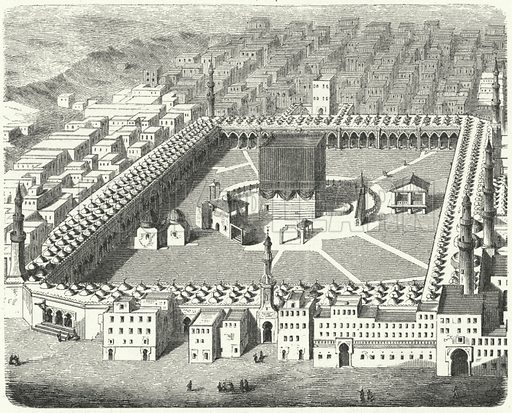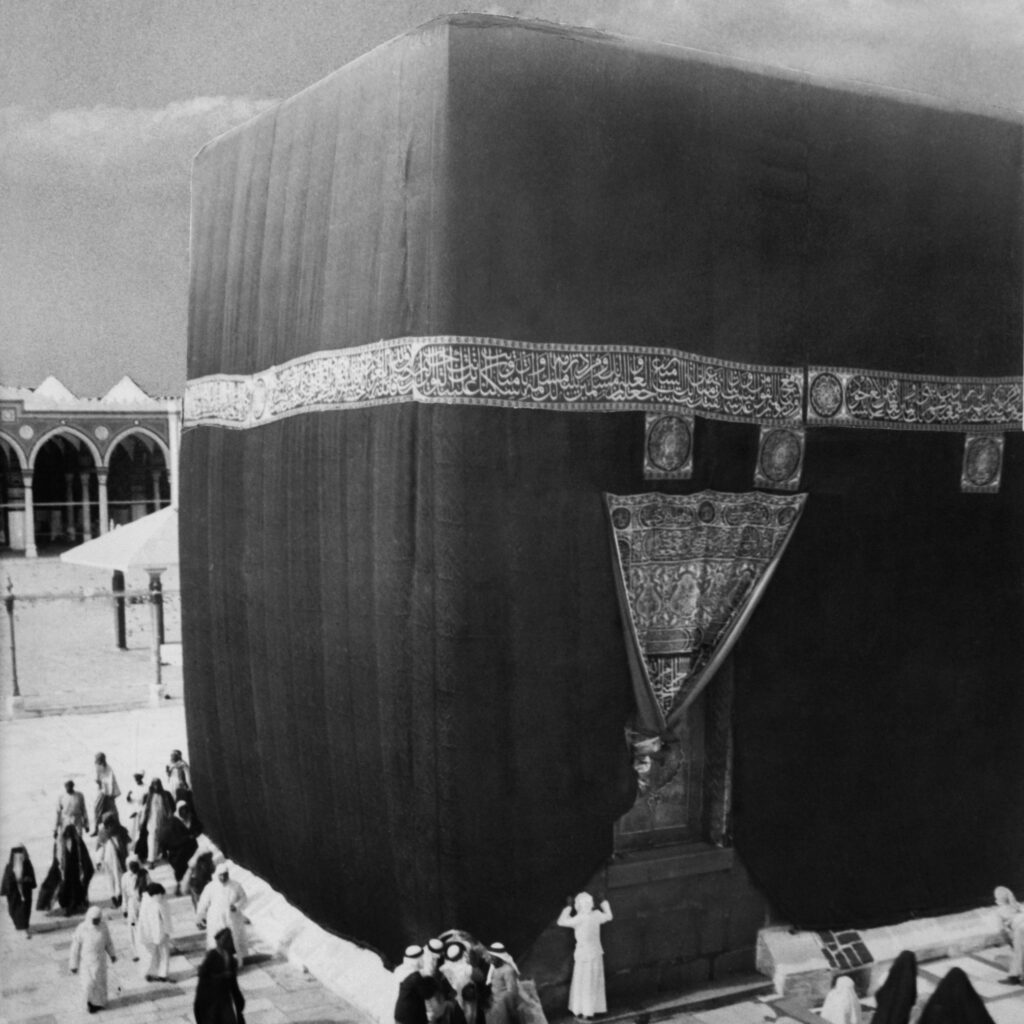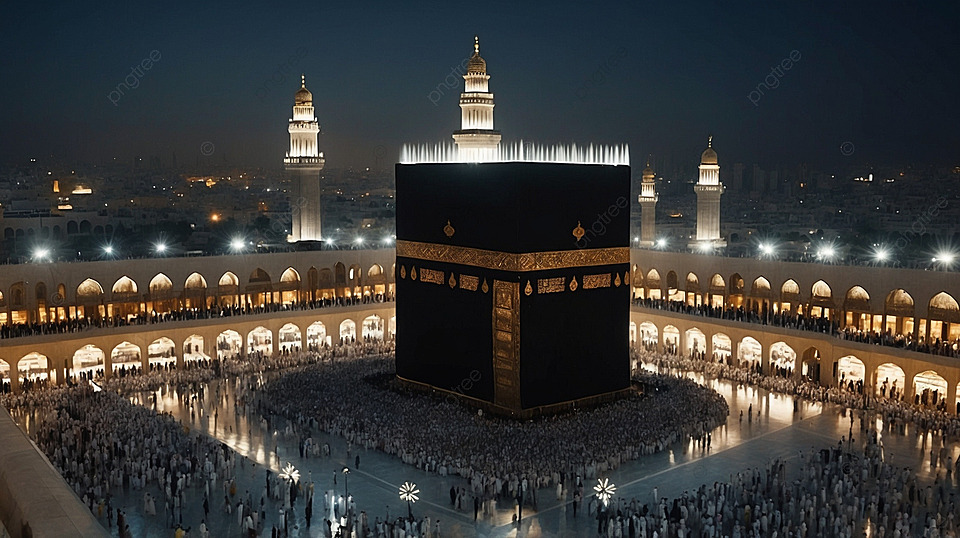The Kaaba, located in the heart of the Holy Mosque in Mecca, is the most sacred site in Islam. As the focal point of Muslim worship, the Kaaba holds profound significance in the lives of Muslims around the world. This article explores the historical, spiritual, and architectural importance of the Kaaba and explains why over a billion Muslims revere it.
What is the Ka’aba?
The Ka’aba (“cube”) is the most sacred site in Islam, known as the sacred bayt Allah (House of God). It is located at the heart of the sacred mosque Masjid al-Haram in Mecca, Saudi Arabia.
Who built the Ka’aba?
Commanded by Allah (SWT), Prophet Ibrahim (AS) first built the Ka’aba:
“And remember Ibrahim and Ismail raised the foundations of the House (With this prayer): “Our Lord! Accept (this service) from us: For Thou art the All-Hearing, the All-knowing.”
Quran, 2:127
History of the Ka’aba
In the early days of Islam, Muslims would pray facing Jerusalem. Now, we pray facing Makkah following the Qur’anic revelation to change direction.
Now, turn your face in the direction of the Sacred Mosque (Al-Masjid-ul-Harām), and (O Muslims), wherever you are, turn your faces in its direction.”
Quran, 2:144
In 632 CE, Prophet Muhammad (SAW) led his first and final Hajj here when he led a group of worshippers.
The Origin of the Kaaba: Built by Prophet Ibrahim and Ismail
The story of Prophet Ibrahim (Abraham) and his son Ismail (Ishmael) deeply roots the Kaaba’s origin.
The residents around the Kaaba during this time included Ismail and the tribe of Jurhum, originally from Yemen. The builders designed the Kaaba, nearly square in shape, with its sides strategically facing the cardinal points of the compass. This design not only symbolized the universality of Islam but also ensured that the winds, no matter how strong, would not harm the structure. The construction by Ibrahim and Ismail stood intact for many years, preserving its sanctity as a house of worship.
The First Rebuilds: Al-Amaliqah and the Tribe of Jurhum
The tribe of al-Amaliqah first rebuilt the Kaaba, followed by the tribe of Jurhum, or possibly in the reverse order.
The Kaaba Under Qusayy Ibn Kilab: Firm Foundations and Council House
Centuries later, Qusayy Ibn Kilab, an ancestor of the Prophet Muhammad (SAW), took charge of the Kaaba’s management. This occurred in the second century before the Hijrah (migration). Qusayy demolished and rebuilt the Kaaba on firmer foundations, ensuring its durability. He also introduced a roof made of doom palm timber and date-palm trunks, further enhancing the structure’s resilience.
Qusayy’s contributions did not stop at the Kaaba itself. He also built ‘Daru ‘n-Nadwah,’ the Council House, on one side of the Kaaba. This council house became the center of Qusayy’s rule, where he held counsel with his colleagues and made important decisions. Additionally, Qusayy divided the various sides of the Kaaba among different clans of the Quraysh tribe. Each clan built their houses on the side allotted to them, with doors opening towards the Kaaba, signifying their connection to this sacred site.
The Great Flood and the Reconstruction by the Quraysh
Five years before the Prophet Muhammad (SAW) received his first revelation, a devastating flood struck Mecca, severely damaging the Kaaba. The Quraysh tribe, responsible for the Kaaba’s upkeep, decided to rebuild it. They divided the various responsibilities connected with the reconstruction among themselves, demonstrating their collective dedication to preserving the Kaaba.
To ensure the quality of the reconstruction, the Quraysh hired a Roman builder and an Egyptian carpenter. Their skills were instrumental in rebuilding the Kaaba with the best materials available. However, the reconstruction effort was not without its challenges. When it was time to place the Black Stone (Hajar al-Aswad) back in its position, a dispute arose among the Quraysh clans about who should have the honor of placing it. The wise decision of the Prophet Muhammad (SAW), who was then thirty-five years old, resolved the dispute.
Despite their efforts, the Quraysh found their funds exhausted before they could complete the Kaaba to its original dimensions. As a result, they reduced the size on one side, leaving out a portion of the original foundation.Today, we know this excluded area as ‘Hijr Ismail’ (the Enclosure of Ismail), and it remains a significant part of the Kaaba’s history and structure.
The Kaaba During the Siege of Makkah and the Rule of Abdullah Ibn Az-Zubair
The Kaaba’s history took another dramatic turn during the reign of Yazid Ibn Muawiyah when Abdullah Ibn Az-Zubair established his rule over Hijaz. During a siege led by Husain Ibn Numair, catapults struck the Kaaba, causing significant damage. The Kiswah (covering of the Kaaba) and some roof timbers burned, leaving the structure in ruins.
After the siege was lifted, news of Yazid’s death reached Makkah. Abdullah Ibn Az-Zubair, determined to restore the Kaaba to its original foundation, decided to demolish and rebuild it. He procured high-quality mortar from Yemen and constructed a new building, which re-included Hijr Ismail within the Kaaba’s boundaries. He also introduced two doors, one for entering and the other for exiting, to facilitate the flow of pilgrims. The builders increased the height of the Kaaba to twenty-seven arms, perfumed the entire structure, and covered it with a silken Kiswah. They completed this reconstruction on 17th Rajab, 64 A.H., marking a significant moment in the Kaaba’s history.

The Kaaba Under Abdul-Malik Ibn Marwan and Hajjaj Ibn Yusuf
The Kaaba’s structure was altered once again when Abdul-Malik Ibn Marwan came to power in Damascus. After defeating Abdullah Ibn Az-Zubair, his commander Hajjaj Ibn Yusuf inspected the Kaaba and noticed the changes made by Ibn Az-Zubair. Abdul-Malik ordered the Kaaba to be returned to its previous shape as constructed by the Quraysh. Hajjaj demolished six and a half arms from the northern side, raised the eastern door, and closed the western one, effectively reverting the Kaaba to its pre-Ibn Az-Zubair state.
Ottoman Contributions and the Great Flood
The Ottoman Sultans also played a crucial role in the maintenance and renovation of the Kaaba. Sultan Sulaiman, who ascended the throne in 960 A.H., changed the roof of the Kaaba, ensuring its continued protection from the elements. Later, Sultan Ahmad, who came to power in 1021 A.H., made further repairs and alterations to the structure.
However, the Kaaba faced yet another challenge with the great flood of 1039 A.H. The flood damaged parts of the Kaaba’s northern, eastern, and western walls, prompting the Ottoman Sultan Murad IV to order extensive repairs. These repairs ensured that the Kaaba remained standing and continued to serve as the focal point of Islamic worship. The building, as it was reconstructed under Sultan Murad IV, has remained largely unchanged to this day.
The Shape and Structure of the Ka`bah
The Kabah is a nearly square structure built with hard, dark bluish-grey stones, reflecting its ancient and resilient design. Currently, the Kabah rises to a height of sixteen meters, though it was significantly lower during the time of the Prophet Muhammad (peace and blessings be upon him). This is evident from the account of the Prophet lifting Ali Ibn Abu Talib onto his shoulders to remove and destroy the idols on the roof of the Ka`bah during the conquest of Makkah.
The dimensions of the Kabah are precise and carry deep significance. The northern wall, which faces the Enclosure of Ismail (Hijr Ismail) and features the Trough of Mercy (Mizab al-Rahmah), and the opposite southern wall each measure ten meters and ten centimeters in length. The eastern wall, which has the door, and the opposite western wall measure twelve meters long. The door of the Ka`bah sits two meters above ground level, requiring the use of a staircase for entry.
An essential feature of the Ka`bah is the Black Stone (Hajar al-Aswad), embedded in the east-south corner. Positioned one and a half meters above the circumambulation area (Mataf), the Stone greets those entering the door on their left. The Black Stone, with its irregular oval shape and a diameter of about thirty centimeters, is black with a reddish tint. Over time, red dots and yellow wavy lines have appeared on the Stone due to the soldering and joining of broken pieces.
The Corners of the Ka`bah
The corners of the Ka`bah hold great reverence and each has a specific name: the northern corner is the Iraqi Rukn, the western is the Syrian Rukn, the southern is the Yemenite Rukn, and the eastern corner, where the Black Stone is located, is the Black Rukn.
Atop the northern wall sits the Trough of Mercy (Mizab al-Rahmah), a feature introduced by Al-Hajjaj Ibn Yusuf. This trough has been replaced over the years by different rulers, with the current one being made of gold, installed by Sultan `Abdul-Majid in 1273 A.H.
Opposite the northern wall is Al-Hatim, a half-circle wall resembling a bow, with its ends facing the Iraqi and Syrian Rukns. The gap between the ends of Al-Hatim and these Rukns measures two meters and three centimeters. Al-Hatim stands one meter high and one and a half meters wide, and features carved marble panels. The space between Al-Hatim and the northern wall, called Hijr Ismail, includes about three meters that originally belonged to the Kaabah built by Prophet Ibrahim (peace and blessings be upon him).
The Covering of the Ka`bah
The Kabah, the holiest site in Islam, has been adorned with a covering known as the **Kiswah** since ancient times. The tradition of covering the Kaaba began with the Tubba’ kings of Yemen, starting with Tubba Abu Bakr As’ad.
Qusayy, an ancestor of the Prophet Muhammad (peace and blessings be upon him), established the practice by imposing a tax on the Arabs to ensure that they placed a new covering on the Kaaba annually.
During the time of the Prophet Muhammad (peace and blessings be upon him), the Kabah was covered with Yemenite sheets, a custom that continued after his time. When the Abbasid caliph Al-Mahdi visited the Ka`bah during his pilgrimage, the attendants of the House expressed concern about the accumulated weight of the coverings on the roof, fearing it might collapse.Al-Mahdi responded to their concerns by ordering the removal of all old coverings and establishing a new custom: replacing the old covering with a new one each year. This tradition continues to this day.
The mother of Abbas started draping the Kaaba from the inside to fulfill a vow related to her son.
Modifications to the Ka`bah
- Early Expansions and Renovations: The second caliph, Umar ibn al-Khattab (ruled 634–644), expanded the area around the Kabah to accommodate more pilgrims. His successor, `Uthman ibn Affan (ruled 644–656), built colonnades around the open plaza and incorporated important monuments into the sanctuary.
- During the civil war between Caliph Abd al-Malik and Ibn Zubayr in 683 CE, the Kaaba caught fire. Reports indicate that the Black Stone broke into three pieces and that Ibn Zubayr reassembled it with silver.
Ibn Zubayr rebuilt the Kabah using wood and stone, following the dimensions set by Prophet Ibrahim (peace and blessings be upon him) and paved the area around it. After Abd al-Malik regained control of Mecca, he restored the building to its original design. - During the Umayyad period, under Caliph al-Walid (ruled 705–715), the mosque surrounding the Kaaba featured decorations with mosaics, similar to those in the Dome of the Rock and the Great Mosque of Damascus. By the seventh century, the Kaaba was covered with kiswa, a black cloth replaced annually during the Hajj. The Abbasid period (750–1250) saw multiple expansions and modifications to the mosque around the Kaaba.
Travel writers like Ibn Jubayr, who visited in 1183, reported that the Kabah retained its Abbasid form for several centuries. - Mamluk and Ottoman Renovations: From 1269 to 1517, the Mamluks of Egypt controlled the Hijaz, where Mecca is located. Sultan Qaitbay (ruled 1468–1496) constructed a madrasa (religious school) adjacent to the mosque. The Ottoman sultans Süleyman I (ruled 1520–1566) and Selim II (ruled 1566–1574) heavily renovated the complex. In 1631, after floods had demolished the Kabah and the surrounding mosque, a complete reconstruction was carried out. This mosque, which exists today, features a large open space with colonnades on four sides and seven minarets—the largest number of any mosque in the world. The current structure includes the Kabah at its center, surrounded by many other holy buildings and monuments.

The Black Stone
The Black Stone (Hajar al-Aswad), one of Islam’s most venerated objects, is located in the Kaaba’s eastern corner.
Description and Appearance
The Black Stone sits in the southeastern corner of the Ka`bah in Masjid al-Haram, Islam’s holiest mosque.
Historical and Religious Significance
Origin: Islamic tradition states that Allah sent the Black Stone from Heaven to Prophet Ibrahim (Abraham) and his son Isma`il (Ishmael) as a divine sign. It originally appeared white but turned black due to the accumulation of human sins over time.
Role in Pilgrimage: The Black Stone plays a crucial role in the rituals of Hajj and Umrah, the Islamic pilgrimages to Mecca. During Tawaf, pilgrims walk around the Ka`bah seven times, and the Black Stone is a focal point of this ritual. Pilgrims aim to touch or kiss the Black Stone as a sign of respect and to seek Allah’s blessings. This act of reverence is deeply rooted in the Sunnah, the practices and traditions of the Prophet Muhammad (peace and blessings be upon him).
Symbolism: The Black Stone represents the unity of the Muslim Ummah (community) and serves as a physical link between the earthly and the divine. It is considered a repository of prayers and supplications, absorbing the spiritual hopes of those who visit it. Its presence at the Ka`bah underscores the connection between the faithful and their Creator.
Historical Events and Repairs
Throughout history, the Black Stone has faced various challenges. During the civil war between the Umayyad caliph Abd al-Malik and Ibn Zubayr, the Kaaba and its Black Stone sustained damage. In 683 C.E., the Black Stone broke into several pieces. Ibn Zubayr reassembled the stone with silver, and later, Abd al-Malik restored the parts of the Kaaba that the Prophet Muhammad (peace and blessings be upon him) had originally designed.
Despite these trials, the Black Stone remains a symbol of endurance and faith. It has been carefully preserved and continues to hold a central place in the spiritual lives of Muslims.

The Black Stone in Islamic Tradition
Several hadiths (sayings of the Prophet Muhammad) highlight the importance of the Black Stone. The Prophet Muhammad (peace be upon him) kissed the Black Stone and urged Muslims to revere it as sacred.
Spiritual Connection: For Muslims, the Black Stone represents a tangible link to the divine. Touching or kissing the stone is believed to bring blessings, forgiveness, and a sense of closeness to Allah. The rituals associated with the Black Stone are imbued with deep spiritual significance, reflecting the rich traditions of Islamic worship.
Prayer and Pilgrimage
Prayer: In Islam, prayer is a fundamental act of worship. Muslims are required to pray five times a day. After 624 CE, they established the direction of these prayers (qibla) towards Mecca and the Kaaba instead of Jerusalem.
Pilgrimage: One of Islam’s Five Pillars, is required for Muslims who can physically and financially undertake it at least once.
This ritual is a significant component of the Hajj pilgrimage and symbolizes unity, devotion, and submission to Allah.

